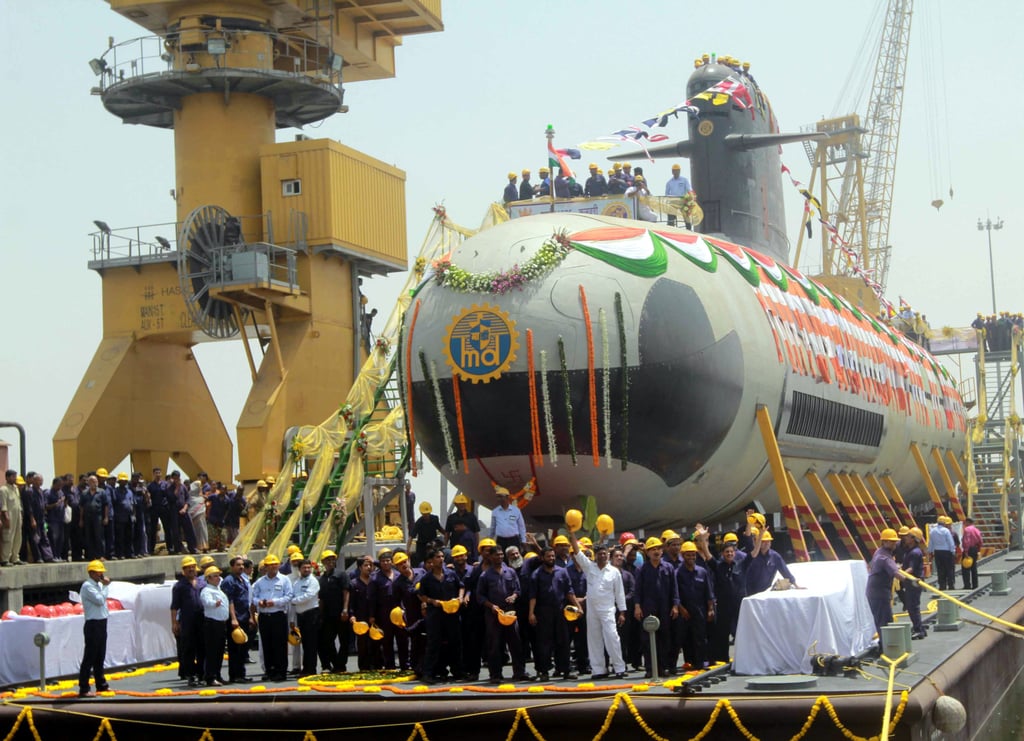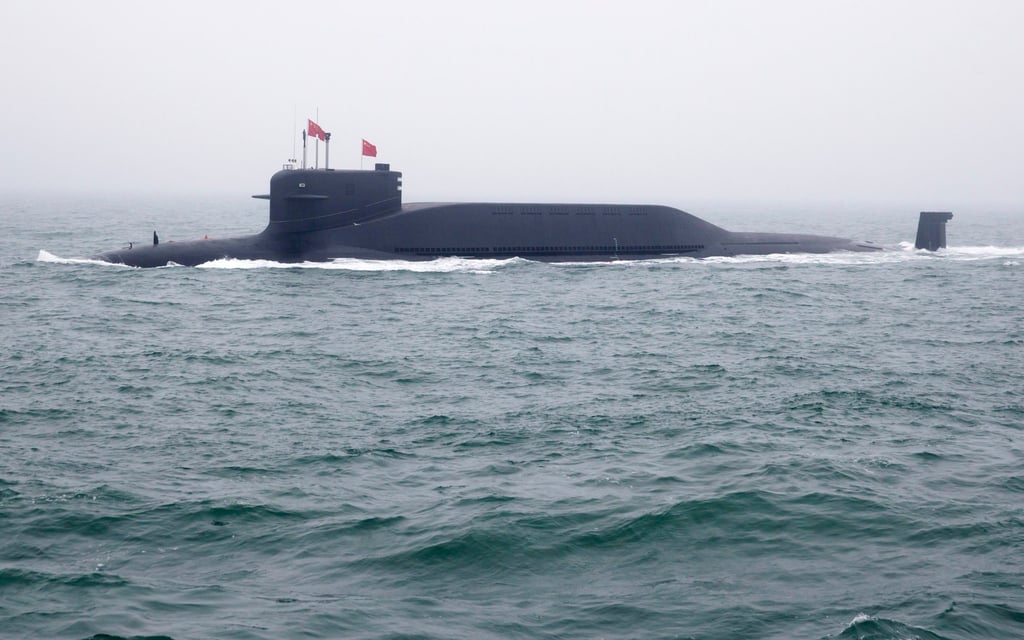India’s recent launch of its second nuclear-powered ballistic missile submarine may have boosted its deterrence capabilities, but analysts say the country has a long way to go in closing the gap on China’s naval power.
Unveiled last week in the port city of Visakhapatnam, the domestically developed INS Arighaat is armed with K-15 missiles that boast a striking range of 750km (466 miles). At the launch, Defence Minister Rajnath Singh expressed confidence that this new submarine would fortify India’s nuclear deterrence and play a decisive role in national security.
He said the INS Arighaat would join its predecessor, the INS Arihant, in bolstering India’s “nuclear triad” – the ability to launch nuclear weapons from land, sea and air.
The submarine’s introduction was timely, according to former chief of India’s naval staff Admiral Arun Prakash, amid challenges posed by the country’s two nuclear-armed neighbours: Pakistan and China.
Prakash highlighted the stark contrasts in nuclear policies among these nations.
“India’s 2003 doctrine states that it will not be the first to use a nuclear weapon ever whereas Pakistan has made no such commitment and it keeps threatening it would use nuclear weapons when required,” he told This Week in Asia. “China also adopts the ‘no first use’ policy but its intentions are not clear.”
The strategic landscape is further complicated by the INS Aridhaman, expected to be commissioned early next year. Currently undergoing trials, according to the Times of India, the submarine is larger than both its predecessors and designed to carry longer-range nuclear missiles.
While these advancements signal progress in India’s defence sector, Prakash insists that the country must prioritise indigenous technology.
“Importing technology from abroad is a good step but it is not the ultimate [solution]. Technology takes many years to develop and we should be looking at India-developed technology.”
Powered by 83 megawatt pressurised light-water reactors, both the INS Arihant and INS Arighaat can remain submerged longer than conventional diesel-electric submarines.
India aims to build a fleet of five Arihant-class submarines and six nuclear-attack submarines as part of a comprehensive three-phase development strategy.

These long-term plans come against a backdrop of escalating competition between India and China for influence in the Indian Ocean region and wider Indo-Pacific. Tensions spiked in 2020 when both countries clashed at their shared border in the Galwan Valley.
Former Indian naval officer Commodore C Uday Bhaskar said the commissioning of the Arighaat was a significant development within the country’s strategic Indo-Pacific framework, especially considering China’s “creeping assertiveness” along its border with India.
Only five other countries – the United States, Russia, Britain, France and China – have nuclear-powered ballistic missile submarines (SSBNs) in their arsenal, Bhaskar pointed out.
“Neighbouring nations will be cognisant of the progress being made by India since it doesn’t have a strong and vibrant domestic [defence] manufacturing and hi-tech design capabilities,” he said, adding that Pakistan would be closely monitoring India’s growing naval power.
Despite these advancements, the Chinese navy remains far superior, particularly in submarine capabilities, Bhaskar said. He stressed that India should work to acquire longer-range submarine-launched missiles to keep pace.
“China’s nuclear arsenal is much greater in quantity, more potent in quality and is growing … Against this backdrop, the INS Arighaat and the INS Arihant will serve to enhance India’s second-strike capability but in a very modest manner,” Bhaskar said, referring to the ability of a country to counter a first-strike nuclear threat.

China has recently integrated Shang-class nuclear-powered attack submarines and Jin-class ballistic missile submarines into its fleet, alongside developing the newer Tang-class, noted Atul Kumar, a fellow of the New Delhi-based Observer Research Foundation think tank’s strategic studies programme.
Media reports indicate that China operates six Jin-class submarines armed with JL-3 missiles capable of striking targets up to 10,000km away.
“The Shang-class submarines have been conducting familiarisation missions in the Indian Ocean,” Kumar said. “China’s nuclear missile submarines, armed with JL-2 and JL-3 intercontinental ballistic missiles, can target New Delhi from the South China Sea.”
India acquiring SSBNs was crucial for it to maintain a balance of naval power against China, said Dongkeun Lee, a PhD candidate at Australian National University’s Strategic and Defence Studies Centre.
“SSBNs are valuable because they provide advantages in escalating dominance during potential contingencies by offering second-strike capabilities at sea, which are harder to detect compared with land-based systems,” he said.
India’s push to develop these submarines is a direct response to China’s expanding influence, according to Lee – particularly in the Indian Ocean, where Beijing is actively engaging with countries like Pakistan, the Maldives, and Myanmar through its Belt and Road Initiative to grow global trade.
“Considering the geographic context, if China fully integrates these countries, it could potentially encircle and isolate India maritime-wise,” he said. “Alongside the existing SSBN, INS Arighaat can help deter such actions by providing second-strike capability advantages and ensuring a more favourable maritime security environment in the Indian Ocean.”

A strategic advantage for India, Lee said, is that China lacks regional allies with SSBNs, while Delhi has been strengthening its defence ties with Washington.
“The balance of sea-based nuclear capabilities favours India due to its coordination with the US and the INS Arighaat can further strengthen this advantage,” he said.
However, Kumar cautions that the INS Arihant and INS Arighaat are still in the early stages of establishing India’s second-strike capability and are limited by their relatively small reactors and missile ranges.
“While these submarines may provide deterrence against Pakistan, they are inadequate to counter the strategic threat posed by China,” he said.
To address these challenges, the Indian Navy must undertake a comprehensive expansion that includes not only SSBNs but also aircraft carriers and nuclear-powered attack submarines (SSNs), Kumar said.
“Neighbouring countries are rapidly expanding their submarine capabilities,” he said.
“India’s aircraft carriers and SSBNs need effective screening and protection, and SSNs are a priority that demands immediate attention. India’s deterrence requirements demand larger submarines with bigger reactors and longer-range missiles.”

